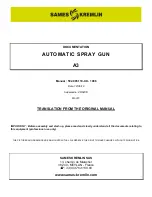
15
2. Remove the transaxle dipstick and wipe it with a clean
rag (Fig. 10).
1
2
Figure 10
1.
Dipstick
2.
Fill hole
Important
Be very careful not to get dirt or other
contaminants into the opening when checking the
transmission oil.
3. Insert the dipstick into the tube and make sure it is
seated fully. Remove the dipstick and check the oil
level.
4. The transaxle fluid level should be at the top of the flat
portion of the dipstick. If it is not, fill the reservoir with
the appropriate fluid; refer to Changing the
Transaxle/Hydraulic Fluid, page 33.
5. Install the dipstick firmly in place.
Filling the Fresh Water Tank
The sprayer is equipped with a fresh water tank (Fig. 11)
for you to wash chemicals off of your skin, eyes, or other
surfaces in the case of accidental exposure. Always fill the
fresh water tank with clean water before handling or
mixing any chemicals.
1
2
3
Figure 11
1.
Filler cap
2.
Fresh water tank
3.
Spigot
To open the fresh water tank spigot, turn the lever on the
spigot toward the front of the sprayer.
Operation
Note: Determine the left and right sides of the machine
from the normal operating position.
Think Safety First
Please carefully read all of the safety instructions and
decals in the safety section. Knowing this information
could help you or bystanders avoid injury.
Vehicle Controls
Accelerator Pedal
The accelerator pedal (Fig. 12) gives you the ability to vary
ground speed of the sprayer. Pressing the pedal increases
ground speed. Releasing the pedal will slow the sprayer and
the engine will idle.
m–6203
2
1
Figure 12
1.
Accelerator pedal
2.
Brake pedal
Brake Pedal
Use the brake pedal to stop or slow the sprayer (Fig. 12).
Brakes can become worn or can be misadjusted
resulting in personal injury.
If brake pedal travels to within 1 inch (2.5 cm) of
the sprayer floor board, the brakes must be
adjusted or repaired.
Caution
















































